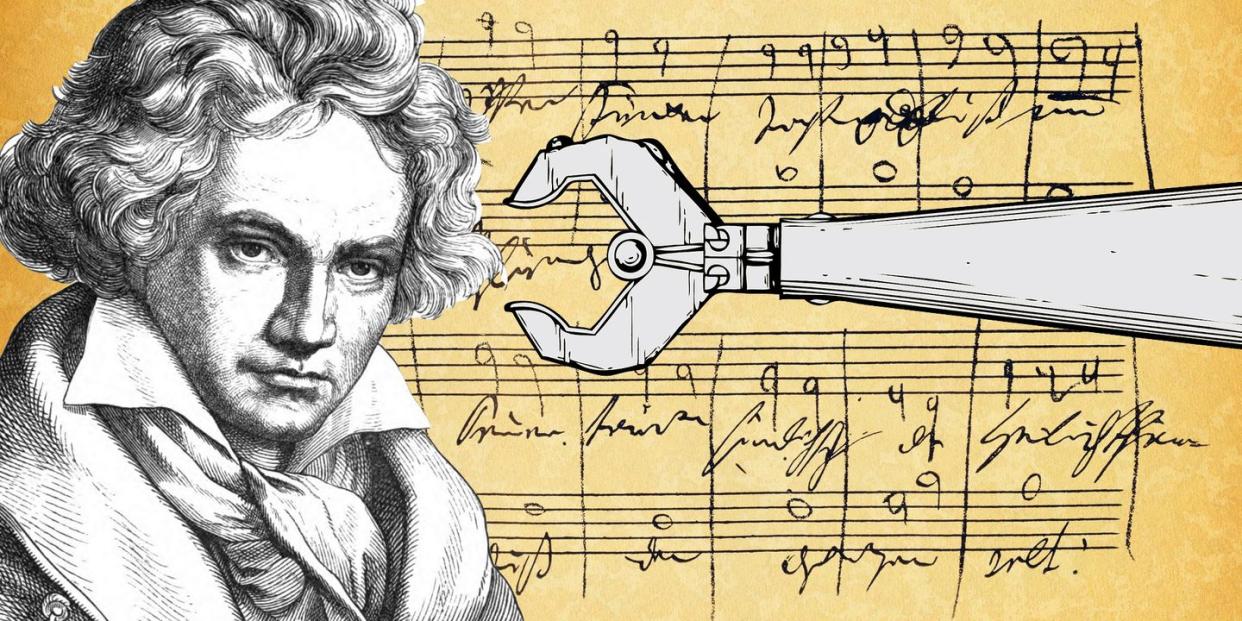Beethoven Never Finished His Last Symphony. Can Robots Complete the Job?

A machine learning algorithm is iterating suggestions for how Beethoven might have written his final symphony.
Scholars aren't impressed, but the exercise is more about the algorithm than an intent to join the canon.
Algorithms have been used to identify Shakespeare, but music and visual art remain elusive.
Ludwig von Beethoven’s unfinished last symphony is being completed by artificial intelligence, Yahoo! reports. Beethoven died at age 56 in 1827. The work on his 10th and final symphony is part of a yearlong celebration of the composer’s 250th birthday on December 17, 2020. The decision to use AI is polarizing in the classical musical community, but Beethoven’s work in particular has been the subject of a lot of technological attention for decades.
In 1824, Beethoven finished his legendary ninth symphony in D minor, the one that includes “Ode to Joy.” After that, he began work on a 10th symphony that wasn't just never completed—it’s so incomplete that scholars aren’t certain when partial drafts or sketches of musical ideas are even related to it. And efforts to complete it have also gone on for decades, causing uncomfortable arguments between prominent scholars.
They compare it to Gustav Mahler’s similar unfinished 10th symphony, which has a fully orchestrated first movement and a complete entire draft in a simplified score form. Mahler’s work was completed by a musical scholar named Deryck Cooke, who studied Mahler all his career and felt able to extrapolate, with caveats, based on the extensive outline Mahler left. Far from composing or even orchestrating, he felt he was just building to a blueprint. “‘[O]rchestrate’ is not quite the right word here; Mahler conceived this music orchestrally, and his short scores are blueprints for instrumentation,” Cooke wrote. When this work is performed, Cooke’s involvement is prominently noted both as a credit and an explanation.
In contrast, Beethoven’s final work is, in the literal and figurative senses, much more sketchy. Many scholars argue there just isn’t enough of Beethoven’s final symphony to complete it in a responsible way, with surviving sketches of only the first movement and no example of a fully orchestrated version. Cooke felt able to do justice to Mahler’s final work because he had examples of what he believed were Mahler’s whole vision for three of the five sections. For Beethoven’s 10th, there’s no such example.
Germany’s national 250th birthday celebration for Beethoven has drawn fresh attention to the unfinished symphony, and the team’s project to “complete” the symphony is more of an experiment in AI composition with a Beethoven focus. Like the machine learning that scholars are using to sniff out the real William Shakespeare, these scholars have given their algorithm all of Beethoven’s works and used that to build a profile. From this, they ask the algorithm to analyze what little Beethoven left of the 10th symphony and extrapolate from there.
It’s more of an abstract science experiment than, say, a cohesive yet still hotly debated Tupac Shakur hologram. Even previous human scholarly efforts to complete a draft of only the first movement of the symphony have been classified strictly as experiments, compared with the performable and reasonably respected Mahler 10th symphony synthesized by Cooke.
So far, Beethoven scholars aren’t impressed. Barry Cooper, a world-renowned Beethoven expert who has sketched a complete first movement in the past, told Yahoo!, "I listened to a short excerpt that has been created. It did not sound remotely like a convincing reconstruction of what Beethoven intended.”
You Might Also Like

